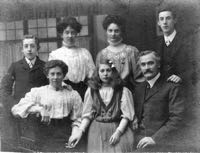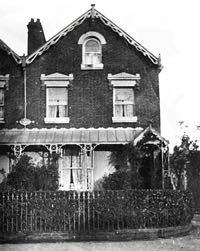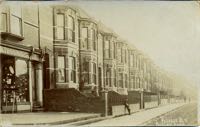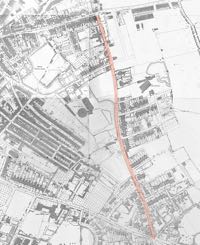
Polsloe Road
Page updated 14th February 2020
Polsloe derives from Poll's marsh, Poll being the landowner on which Polsloe Priory had been built in Saxon times, and was recorded in Domesday after the Norman invasion. Polsloe Road follows the line of an Iron Age ridgeway track from Salmon Pool on the Exe, up Barrack Road, then Polsloe Road to join a similar trackway from the High Street that terminates at Stoke Hill.
Called Workhouse Road after the Heavitree Workhouse, now Heavitree Hospital, it was renamed Polsloe Road by the Improvement Commission in January 1864. The boundary between Heavitree and the city runs along Polsloe Road, which caused several disputes between the City and Heavitree over the maintenance of the city side footpath; in 1876 the City Council discovered that they had been maintaining the footpath illegally. The earliest mention of Polsloe Road in the Flying Post was when the Improvement Commission considered a request for a lamp to be placed in the road in 1865. In the same year 1 and 2 Polsloe Villas, Polsloe Road were for rent. There was a letter in 1866 complaining of the 'ugly... laying out' of the land belonging to the Freehold Land Society in Polsloe Road.
Discombe Villas were originally 1 & 2, but were renumbered by 1912. Tom Shute lived with Helena his wife and five children in number 56. He was a cab driver, groom and gardener.
1897 - DlSCOMBE VILLAS
2 Willis Edward - Kelly's
1912 - 56,Thomas Shute - Besley's
1919 - 56, Tom Shute - Kelly's
1923 - 56, Jocylyn Pyne - Post Office
The Devon and Exeter Female Reformatory and Refuge for discharged Prisoners, built in 1858, for the employment and instruction of girls was also situated in Polsloe Road. The building was, until recently, the Nichols Centre, a centre for special needs adult training. It has been turned into housing. In 1871 consideration was made for building a smallpox hospital in the the road, much to the disgust of one irate letter writer in the Flying Post.
Polsloe Road was flanked by brick and tile works - to the west was Hancock and Sons, on what is now, the Clifton Hill Sports Centre site, and to the east, Sampson Junior, brick and tile manufacturers behind Park Villas, to the south of Park Road. Many of the houses in Polsloe Road would have been built of local brick. By 1900, a typical, newly constructed house in the road would have sold for £ 375.
World War One Dead - Polsloe Road
Third Officer, George
Brand Carter, S.S. "Conch" (London), Mercantile Marine. 7 December
1916. Age 41. Polsloe Rd., Exeter.
Private, Robert Reid Young, Devonshire Regiment. 17 June 1915. Age 28.
Polsloe Rd
Lieutenant, Edward Stanley Mathews, Middlesex Regiment. 26 September
1918. Age 34. Polsloe Rd
The 1942 bombing
Polsloe Road suffered during the May 1942 blitz. Number 38 was reported as destroyed and a private house named Fairbank was 'damaged by fire and H.E.'
A report that probably relates to number 38 states that at 0230 on the morning of 4th May 1942:
'Polsloe Rd. Direct on house. 71 ft. from Middle of road 280 ft to middle of Park Road. AL.BO.CO.D3. Water & Gas affected. Killed. 1 female, 1 child.'
The two victims were: Dorothy May Down, age 37, Killed at Polsloe Road Gerald James Reed Down, age 13, Killed at 38 Polsloe Road
Source: Various sources, street directories, Victorian Exeter by Robert Newton and Christopher Shute for the photo.

The Shute family in 1908. From the top left: George, Rose, Beatrice and Frank. Below: Helen, Florence and Tom.
| Top of Page |


